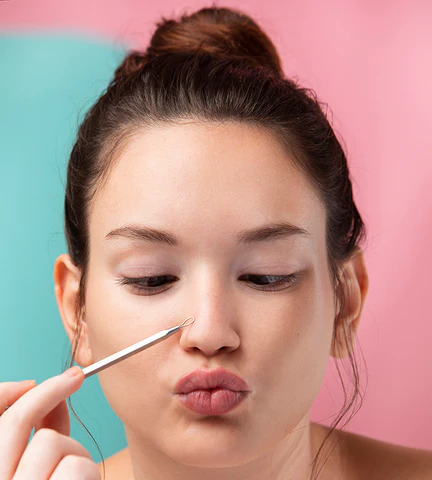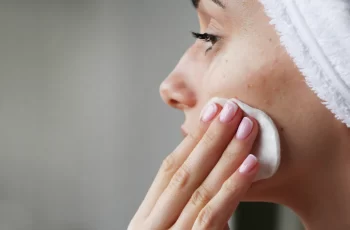
Popping pimples can be incredibly tempting. That little squeeze, leading to the satisfying discharge release, can feel like an irresistible urge. Doctors even have a fancy name for it – extraction. But here’s the deal: Pimple-popping isn’t a wise move and can actually harm your skin if you don’t do it right.
Squeezing a pimple is like inviting bacteria and pus for an underground party, causing more puffiness and redness than a tomato on a hot summer day. Ouch!
But wait, there’s more – it can even lead to scabs and leave you with souvenirs in the form of permanent scars or skin discoloration. Not exactly the kind of memories we’re looking to make, right?
So, here’s the real deal: Patience and Knowledge are your superhero power here.
If you’re determined to tackle that pimple, let’s do it the right way.
Types of pimples
There are several types of pimples or acne lesions, each with its own characteristics and causes. Here are some common types:
Blackheads (Open Comedones): Blackheads are similar to whiteheads, but their pores remain open. The dark appearance is due to the oxidation of the trapped oil and debris, not dirt.
Whiteheads (Closed Comedones): Whiteheads are small, raised bumps with a white or flesh-colored center. They occur when hair follicles become clogged with oil and dead skin cells, but the opening remains closed.
Pustules: Pustules are red, inflamed bumps with a white or yellow center filled with pus. They can be painful and are often referred to as “pimples.”
Cysts: Cysts are larger, pus-filled lumps that form deep within the skin. They are often painful and can cause scarring if not treated properly.
Nodules: Nodules are hard, painful lumps beneath the skin’s surface. They are larger than papules and can be deep-seated. Nodular acne is a severe form of acne.
Papules: Papules are small, raised, solid bumps that are typically pink or red in color. They don’t contain pus but may be tender to the touch.
Acne Rosacea: This type of acne primarily affects the face and is characterized by redness, flushing, visible blood vessels, and sometimes pimple-like bumps.
Why Popping Pimples is a No-No:
Popping a pimple is generally not recommended. Here’s what happens if you pop a pimple and why it’s best to avoid it:
Spread of Acne: Popping a pimple can introduce bacteria from your fingers or nails into the open wound, increasing the risk of infection. This can lead to a more severe and painful pimple or even an abscess. You can even spread acne to adjacent areas.
Permanent Scarring: One of the biggest downsides of popping pimples, (especially when using too much pressure), can damage the surrounding skin tissue and hair follicles, possibly leaving behind small permanent scars.
Worsened Inflammation and Redness: Popping a pimple, even when using proper tools like a comedone extractor, can push the contents deeper into the skin, causing further inflammation. This can make the pimple last longer and become more painful. And the more the skin is inflamed, the weaker and drier it gets.
Delayed Healing: Popping a pimple, even when done properly, disrupts and delays the natural healing process. Instead of letting your skin heal on its own, you create an open wound that takes longer to repair. A pimple, if left alone, will usually disappear in a few days or in a week. A popped pimple usually takes longer to heal, up to a few weeks.
Hyperpigmentation: Popping a pimple can lead to post-inflammatory hyperpigmentation, which is the darkening of the skin in the area where the pimple was. This can take weeks or months to fade.
When to pop, when to stop.
Native Essentials Skincare – Can I pop it?
The general rule is DON’T POP IT. However, regular Blackheads and Whiteheads could be popped.
This extraction, if done following a few key rules, does not disrupt the surface of the skin and in some cases, can prevent even bigger Blackheads.
Here is the ABC of a good and safe extraction:
Wash your hands with antibacterial soap or even better, wear gloves.
Wash your face avoiding harsh, exfoliating cleansers.
Use steam or a warm towel to open your pores and make pimples easier to remove.
If you use a sterilized comedone extractor, center the loop of the tool over the blackhead and apply gentle, even pressure while rocking the tool back and forth slightly.
If you use 2 cotton swabs, apply gentle pressure as you were using your fingers.
Use the tip of a sterilized needle if the opening of the pore is not very visible; poke a small hole on the top of the blackhead to facilitate the extraction.
IMPORTANT: Don’t press so hard that you cut or bruise your skin. If nothing comes out after two, three attempts, or if you see a clear fluid or blood, stop pushing and leave it alone for a day or two. In most cases, your skin will heal by itself.
For stubborn blackheads, we recommend seeing a professional aesthetician or a dermatologist.
A note about Sebaceous Filaments
Sebaceous filaments are naturally occurring, hair-like structures that help keep your skin moist; they guide sebum towards the skin’s surface. They are located in the T-zone and look like tiny greyish, yellowish Whiteheads. Sebaceous filaments are not a form of acne and they don’t cause harm; on the contrary they keep your skin protected and moist. They may look like tiny whiteheads, but they are not.
You should avoid squeezing them, but if you do, be aware that they will fill up again within 30 days.
24 hours Post-Pimple Pop Care:
A popped pimple is an open wound that can easily get infected, and a popped Whitehead may get infected after being popped. Follow these easy steps to support the skin’s natural healing process:
Cleanse Gently: use a mild, non-comedogenic cleanser.
Apply an Antiseptic or Astringent: Use a topical antiseptic like benzoyl peroxide or salicylic acid to disinfect the area and reduce the risk of infection. Avoid overdoing it, as these products can be drying. Use an astringent product to minimize open pores (Witch Hazel extract).
Hydrate: Apply a hydrating serum and or a non-comedogenic moisturizer. This helps with the healing process and improves inflammation.
Hands Off: Don’t scratch it off till it scrubs off on its own.
Avoid Makeup: If possible, skip makeup on the affected area to allow it to breathe and heal without further irritation and to let your pores to shrink (and not fill up again very fast).
Wear Sunscreen: Protect the area from UV rays with a broad-spectrum sunscreen.
Patience: Healing takes time. Be patient and allow your skin to do its job. It may take a few days or even weeks for the area to fully recover.
Acne-prevention strategies:
Having an occasional pimple here and there isn’t a huge deal, especially if associated with hormonal changes of but if you’re regularly finding yourself trying to deal with pimples, it’s important to make sure you’re using products that effectively help prevent acne; like a cleanser containing salicylic acid, a spot treatment containing benzoyl peroxide, retinoids, gentle exfoliants, astringents like Witch Hazel, clay masks, and most importantly, avoid comedogenic skincare products.
If you are battling post-inflammatory hyperpigmentation (dark brown to purplish) or post-inflammatory erythema (reddish), make sure to include in your weekly routine SOLE, with natural exfoliating acids to target hyperpigmentation by speeding up the shedding of pigmented cells.
if your pores tend to clog easily, mask weekly with CHUN, a clay-based purifying and pore minimizing mask that works wonders if used after SOLE or MAMÃO, a gentle exfoliant cleanser for sensitive skin and for rosacea acne.


